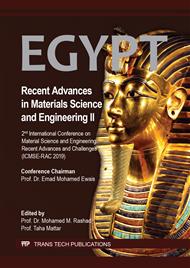p.28
p.41
p.50
p.58
p.68
p.75
p.83
p.93
p.101
Microstructure Evolution of NiTi Magnetron Sputtered Thin Film on Different Substrates
Abstract:
Understanding the microstructure evolution of metal thin films on various substrates is essential for developing thin films that need specific requirements. The microstructure of thin films has been identified to be related to the mobility of the adatoms during growth. Recently, the theory of non-classical crystallisation of thin films has been introduced to explain the structure formation in chemical vapor deposition (CVD) and physical vapor deposition (PVD) processes. Much work has been conducted on CVD deposited thin films, while little data appears on PVD techniques. The effect of substrate material on the microstructure of the deposited nickel-titanium (NiTi) thin film and its optical absorbance is studied in this work. Three different substrates with identified surface conditions were used to deposit thin films of NiTi in the same chamber under the same processing conditions. The NiTi thin film was deposited using radio frequency (RF) PVD sputtering process on stainless steel (SS), aluminium (Al) and copper (Cu) substrates. The results were analysed in view of state of art structure models and mechanisms. The microstructure was studied by scanning electron microscopy (SEM) and X-ray diffraction (XRD). The optical absorbance was measured by spectrophotometery. The results have shown that the structure and morphology of the grown films have varied in all conditions. Amorphous structures were obtained for Al and Cu substrates, while crystalline structures were obtained for the stainless-steel substrate at the same sputtering conditions.
Info:
Periodical:
Pages:
68-74
Citation:
Online since:
March 2020
Keywords:
Price:
Сopyright:
© 2020 Trans Tech Publications Ltd. All Rights Reserved
Share:
Citation:


